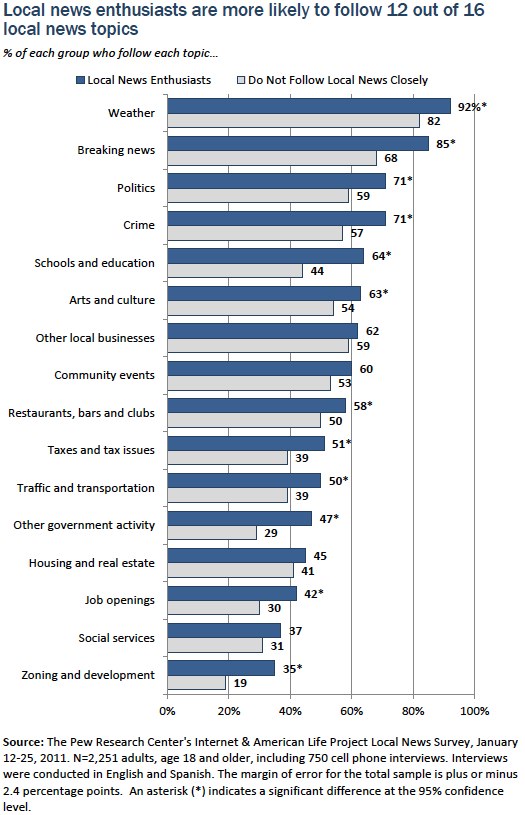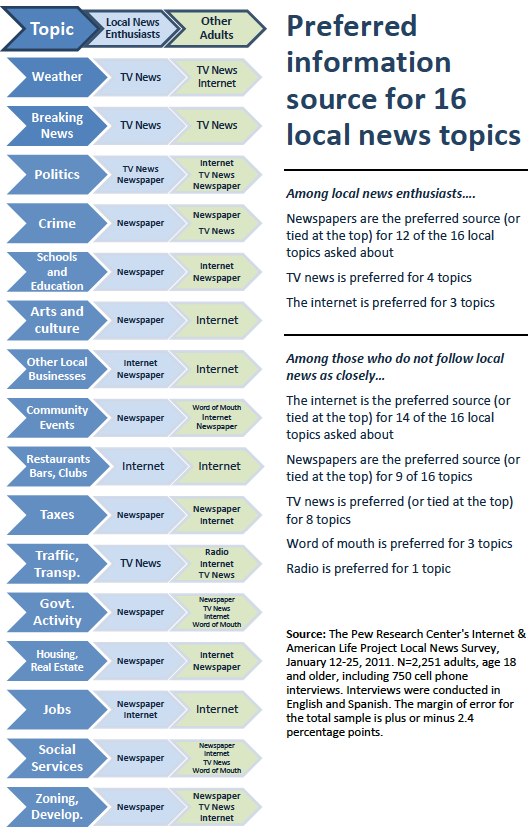Overview
Among all adults, the most closely followed local topics are weather, breaking news, politics and crime, all followed by a solid majority of two thirds or more. Slightly less popular topics but still with a fairly good following of about half or more are arts and culture, local businesses, schools and education, community and neighborhood events, restaurants, taxes and traffic. Fewer survey respondents follow local news about housing, local government activity, job openings, social services, or zoning. Roughly four in 10 adults or fewer follow these local topics.
Both local news enthusiasts and non-enthusiasts follow a wide variety of topics
Local news enthusiasts and non-enthusiasts both follow a wide variety of local topics. In fact, it is somewhat surprising that adults who say they follow local news closely most of the time are no more likely than those who do not to follow four of the 16 local topics asked about, including local businesses other than restaurants, community events, housing and real estate, and social services. And even among those topics which local news enthusiasts are significantly more likely to follow, in many cases the difference between the two groups is 12 percentage points or less (weather, local politics, arts and culture, local restaurants, taxes, traffic, and local job openings).
The handful of local topics which local news enthusiasts as a whole are much more likely than other adults to follow therefore stand out. They are:
- Local schools and education (20 percentage points higher than those who do not follow local news closely)
- Local government activity (18 percentage points higher)
- Breaking community news (17 percentage points higher)
- Zoning (16 percentage points higher)
Yet again, among local news followers there are significant differences by age. In most cases, greater interest in particular topics among local news enthusiasts is driven by the older adults in this group (those age 40 and older). This is true in the case of weather, politics, crime, traffic, taxes, and local government activity, social services and zoning. In contrast, local news enthusiasts’ greater interest in job openings and local restaurants compared to other adults is mainly due to intense interest in these topics among local news followers under age 40.

Local news enthusiasts prefer newspapers for most topics, while others are more reliant on the internet
Local news enthusiasts prefer to follow many local topics through traditional media such as newspapers or television news. For 12 of the 16 topics asked about, newspapers are the top source (or tied as the top source with another platform) among local news enthusiasts. For four of the 16 topics, television news is the preferred source. The internet is the top source for this group for just three topics: restaurants, bars and clubs, other local businesses, and jobs.
In contrast, those less likely to follow local news closely cite the internet as their preferred source (or tied with another platform as the most preferred source) for 14 out of 16 topics. Newspapers and television news top the list for eight and nine topics, respectively, while word of mouth is among the most preferred sources for three local news topics. Overall, those who do not follow local news closely rely on a broader range of sources for the 16 topics asked about, although they are much less likely than local news enthusiasts to follow local news in general.
Local news enthusiasts are heavily reliant on traditional sources, though many are also turning to the internet
Local news enthusiasts’ preference for newspapers as a source of local information is evident across all sixteen topics presented. They are more likely than others to prefer newspapers for almost every topic considered with the exception of weather and breaking news. Three in ten (or more) local news enthusiasts prefer newspapers for following crime (42%), local politics (30%), community events (29%), or arts and culture (29%). One-quarter prefer newspapers when seeking information about local schools (26%), taxes (26%), government activity (23%), other local business (23%), and housing issues (22%), and two in 10 primarily use newspapers for following restaurants (20%), job openings (20%), or local zoning issues (20%). Fewer local news enthusiasts use newspapers as their primary source for information about breaking news (15%), social services (15%), weather (11%) or traffic (10%).
These time sensitive topics (breaking news and weather) are more likely to be followed by this group via television. At least six in 10 prefer television news for following weather (66%) and breaking news (62%). About one-third follow politics (32%) and crime (32%) via TV news and one-quarter (23%) prefer to follow traffic this way. Fewer than two in 10 prefer TV news for information about local government activities (15%), arts and culture (15%), schools (12%) or taxes (12%), and fewer than one in 10 prefer television news for the other seven topics covered. Local news enthusiasts are more likely than other adults to prefer TV for each topic in the survey, with the exception of local businesses, community events, job openings, zoning and social services.
However, in addition to these traditional local news platforms, the internet is a top source for many local news enthusiasts when seeking information about local weather (31%), restaurants (28%) and other businesses (26%). Fewer go to the internet for information about schools (20%), job openings (17%), breaking news (16%), politics (16%), housing (16%), arts or culture (15%), crime (12%), or community events (11%).

Local news enthusiasts are comparable to other adults in their use of radio, mobile phone, word of mouth, or local government as a source of information about local topics. While word of mouth and radio top the list of sources used for a handful of topics among adults who do not follow local news closely, they are not used more widely by that group. Rather, they are at the top of a list of sparingly used sources.
- Radio is used by very few local news enthusiasts as a primary source of information for any of the 16 local topics asked about. Fifteen percent look to the radio for information about traffic. About one in 10 listen to radio for information about weather (10%) or breaking news (9%), and even fewer use the radio for information on any of the other topics.
- Word of mouth is the preferred source for roughly one in ten local news enthusiasts on community events (13%), local restaurants (13%), local businesses (12%), and schools (10%). For the remaining topics, fewer than 10% cite word of mouth as their primary source of information about that topic.
- Mobile phone is cited as the primary source for information about weather by 6% of local news enthusiasts, but for all other topics it is cited by 2% or fewer.
- Local government is cited as the preferred source by 2% or fewer local news enthusiasts for any of these 16 topics, with the exception of taxes (4%) and social services (3%).
Younger local news enthusiasts rely on different local news sources than their older counterparts
While local news enthusiasts’ overall reliance on local newspapers for many topics of interest seems to be positive news for the industry, in most cases it is a reflection of the habits of local news enthusiasts age 40 and older. For many of the topics which older local news followers have routinely turned to newspapers for, younger local news followers prefer non-traditional sources.
Specifically, among local news enthusiasts under age 40, the internet is the preferred source for each of the following topics:
- Local restaurants, clubs and bars (45% of local news followers under age 40 rely mainly on the internet for information about this topic)
- Other local businesses (33%)
- Schools and education (29%)
- Local politics (28%)
- Jobs (27%)
- Housing (21%)
- Arts and cultural events (20%)
- Community or neighborhood events (19%)
These findings may signal significant changes to come in the local news environment, particularly in the delivery of local news to those most interested in following events in their local community.




